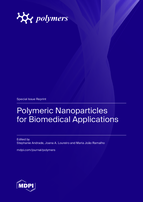Polymeric Nanoparticles for Biomedical Applications
A special issue of Polymers (ISSN 2073-4360). This special issue belongs to the section "Polymer Applications".
Deadline for manuscript submissions: closed (25 November 2023) | Viewed by 43129
Special Issue Editors
2. LEPABE—Laboratory for Process Engineering, Environment, Biotechnology and Energy, Faculty of Engineering, University of Porto, Rua Dr. Roberto Frias, 4200-465 Porto, Portugal
Interests: nanotechnology; polymeric nanoparticles; lipid-based nanoparticles; drug delivery systems; targeted therapy; brain delivery; neurodegenerative disease therapy; effect of compounds on the aggregation and conformation of peptides and proteins; biophysical models; drug–membrane interactions; pharmaceutical and food applications
Special Issues, Collections and Topics in MDPI journals
Interests: nanotechnology and interfacial phenomena; effects of fluorinated systems and peptides on the aggregation of amyloid beta peptides; conformational studies of protein and peptide self-organized systems and polymer surfaces; design and production of inorganic and polymeric nanosystems for pharmaceutical and food applications
Special Issues, Collections and Topics in MDPI journals
ALiCE—Associate Laboratory in Chemical Engineering, Faculty of Engineering, University of Porto, Rua Dr. Roberto Frias, 4200-465 Porto, Portugal
Interests: drug delivery; targeted therapy; brain delivery; brain cancer; glioblastoma; cancer therapy; neurodegenerative disease therapy; biophysical models; drug–membrane interactions
Special Issues, Collections and Topics in MDPI journals
Special Issue Information
Dear Colleagues,
Recently, the use of polymeric nanoparticles has attracted significant attention in biomedical applications. Due to their advantageous properties, including biodegradability, biocompatibility, and non-toxicity, natural and synthetic polymers are versatile materials that offer several advantages for the therapy and diagnosis of a huge range of diseases and health conditions. Encapsulating therapeutic agents in polymeric nanoparticles allows for a sustained drug release, which is beneficial to improve drug efficacy and safety, to reduce unwanted side effects, and to enhance the acceptance and compliance of patients. Polymeric nanoparticles are now established as an important part of the nanotechnology field.
This Special Issue focuses on the recent advances in polymeric nanoparticles and their current applications in healthcare, including the prevention, diagnosis, and treatment of diseases. Authors are welcome to submit their latest findings in the form of original papers and reviews.
Dr. Stéphanie Andrade
Dr. Joana A. Loureiro
Dr. Maria João Ramalho
Guest Editors
Manuscript Submission Information
Manuscripts should be submitted online at www.mdpi.com by registering and logging in to this website. Once you are registered, click here to go to the submission form. Manuscripts can be submitted until the deadline. All submissions that pass pre-check are peer-reviewed. Accepted papers will be published continuously in the journal (as soon as accepted) and will be listed together on the special issue website. Research articles, review articles as well as short communications are invited. For planned papers, a title and short abstract (about 100 words) can be sent to the Editorial Office for announcement on this website.
Submitted manuscripts should not have been published previously, nor be under consideration for publication elsewhere (except conference proceedings papers). All manuscripts are thoroughly refereed through a single-blind peer-review process. A guide for authors and other relevant information for submission of manuscripts is available on the Instructions for Authors page. Polymers is an international peer-reviewed open access semimonthly journal published by MDPI.
Please visit the Instructions for Authors page before submitting a manuscript. The Article Processing Charge (APC) for publication in this open access journal is 2700 CHF (Swiss Francs). Submitted papers should be well formatted and use good English. Authors may use MDPI's English editing service prior to publication or during author revisions.
Keywords
- polymeric nanoparticles
- polymer-based nanoparticles
- drug delivery systems
- surface functionalization
- targeted delivery
- nanocarriers
- nanomedicine
- biomedical application
- therapeutic application
- therapy
- healthcare
- early diagnosis
- theranostics









